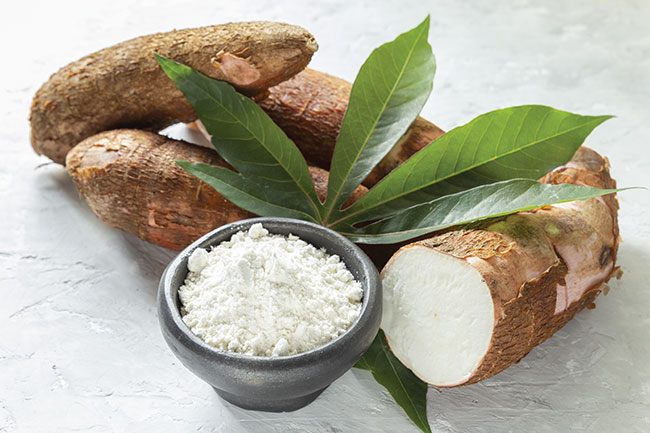
Final Proof: Resistant Starch
August 17, 2020
By
Jane Dummer
What is resistant starch, and how does it contribute to functional wellness?
 Ingredion launched a low FODMAP dietary fibre derived from tapioca, which is classified as a RS4. It carries the official Monash University low FODMAP Certified seal. Photo: AdobeStock-Alexander Ruiz
Ingredion launched a low FODMAP dietary fibre derived from tapioca, which is classified as a RS4. It carries the official Monash University low FODMAP Certified seal. Photo: AdobeStock-Alexander Ruiz Since the announcement of the global pandemic, consumers intend to improve their health through making better eating choices and implementing physical activities. People are focusing on improving their gut health, as a healthy digestive system is associated with a strong immune response. Therefore, breads and baked good formulated to support gut and immune health will provide options for consumers demanding functional wellness.
Gut microbiome research has increased over the past 20 years. Leading to a better understanding the role fibres and prebiotics play in gut health, which has resulted in more product development with these ingredients. Prebiotics are dietary fibers that function as fuel for probiotics, helping them multiply for a healthy gut microbiome. Resistant starch (RS) refers to all starches that are not digested by the time they reach the large intestine. There are four types of RS: RS1 slows down the body’s enzymes from digesting the food and is found in intact whole grains like sorghum and barley; RS2 is a crystalline starch that resists digestion and is found in raw potatoes and green bananas; RS3 is a small amount (up to 10 per cent) of retrograded starch that is created when starch is baked/cooked and then cooled in breads, potatoes, rice, and pasta; and RS4 is a chemically modified starch (synthetic) which cannot be digested or is slowly digested. RS1, RS2 and RS3 have the greatest prebiotic effects.
In the case of bakery products, the incorporation of prebiotics including RS has been seen to improve several technological parameters such as volume, texture along with flavour, aroma, plus nutrition. Rhonda Witwer, resistant starch expert and the Executive Director at ResistantStarchResearch.com identifies, “There are two major categories of resistant starches available for the baking industry: natural and synthetic. Natural sources come from roughly milled grains, along with high amylose grains. Commercially available synthetic ingredients include modified wheat starch, modified tapioca starch and modified potato starch (RS4). These synthetic ingredients maintain their resistant starch through baking, increase the dietary fibre content and can function as a bulking agent, however, they may not deliver similar health benefits as the natural fermentable resistant starches.”
RS2 are recommended for raw food formulations such as non-baked nutrition bars, snacks, and energy bites. If they remain uncooked, these products will deliver the RS2 resistant starch. RS1 such as high amylose grains are recommended for numerous baking applications because they survive the thermal process. Commercially available natural ingredients include high amylose corn, high amylose wheat and most recently, high amylose barley. The higher amylose content increases the gelatinization temperature, therefore, the starch granules do not “cook out” in the baking process.
How do RS stack up against other prebiotics? Witwer identifies, “Within the prebiotic category, research has shown, resistant starch has a significant advantage over inulin and fructooligosaccharides (FOS) because they can be consumed at higher quantity without causing digestive side effects such as bloating, gas, or cramps in healthy people.”
Mariana Macovei, Project Leader Technical Service Canada, Ingredion, identifies, “For bakers, both Artisan and Commercial, resistant starches are appealing. Of course, it’s necessary to consider the market segment they’re addressing, consumers’ interest and claims targeted. For example, Ingredion resistant starches, due to their intrinsic characteristics, are thermal resistant, process stable, are recommended for the baking segment as they have minimal impact on the formulation, process and sensory. Plus, there can be texture improvements of the final product. Ingredion continues to work with researchers around the world to investigate the health benefits of natural resistant starch. Ingredion’s Hi-Maize® Resistant Starch has health benefits related to digestive health, energy management, glycemic and weight management including reduced caloric content. Also, this year in the US, Ingredion launched a low FODMAP dietary fibre derived from tapioca which is classified as a RS4. It carries the official Monash University low FODMAP Certified seal. This diversification level is attractive for customers wanting resistant starches with unique features and benefits to improve and expand their options in the baking sector.”
Witwer is optimistic, “We have the technology to put this nutritional ingredient (RS) into baked goods while maintaining the taste and soft texture we know and love. I believe today’s market will evolve from digestive-oriented messages to include broader categories of health and wellness.”
Jane Dummer, RD, known as the Pod to Plate Food Consultant, collaborates and partners with the food and nutrition industry across North America. www.janedummer.com
Print this page
Leave a Reply